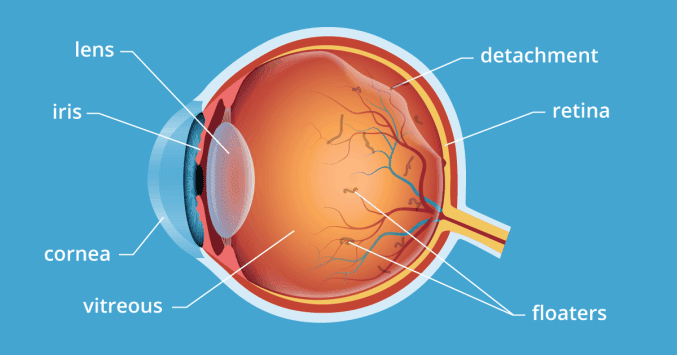
Posterior Vitreous Detachment
September 12, 2020

Most people will see a “floater” at some point, but it is important to determine if the floater is a symptom of a larger problem. A common cause of floaters and flashes of light in the vision is a posterior vitreous detachment (PVD).
What is a PVD?

Before understanding the definition of a PVD, it is necessary to learn the anatomy and physiology of the vitreous. The vitreous is a clear, gel-like substance that fills the space between the retina and lens in the eye. It is primarily composed of water with several types of collagen, proteins, and salts – all increasing the viscosity higher than that of water alone. During the natural aging process of the vitreous, its molecular properties begin to change into that more of a liquid. This watery mixture can have small clumps of vitreous fiber strands that separate from the majority of the vitreous. These are commonly known as floaters.
The retina and vitreous are initially attached at birth. However, as the vitreous gel begins to liquefy in adulthood, it also shrinks, which causes it to slowly pull away from the retina. When the vitreous separates from the retina, it is called a posterior vitreous detachment (“posterior” because it is located in the back or posterior part of the eye and “vitreous detachment” because the vitreous has detached from the retina). Note that a vitreous detachment is completely different and much less harmful than a retinal detachment.
A standard, uncomplicated PVD does not pose a threat to vision like a retinal detachment. However, if the vitreous pulls a portion of the retina along with it, then a retinal tear or detachment has occurred.This can be sight threatening.
Who is at risk for a PVD?
Individuals over 50 years old are at a greater risk for a PVD, which then becomes extremely common in those over 75 years old. Other people at risk include those with:
– Myopia or nearsightedness
– History of ocular trauma
– Previous eye surgery
– History of a PVD in the other eye
What are the symptoms of a PVD?
Usually the first symptom of a PVD is seeing new floaters that are typically different from previously noticed ones. Some people describe their floaters as hair-like strands or cobwebs, while others see circular spots that may vary in color from gray or black to clear.
Another common symptom is the presence of flashing lights in the peripheral vision. It might look like a crescent-shaped flash or have a lightning bolt appearance. As the vitreous gel pulls on the retina during the separation process, the retina is stimulated by the mechanical traction of the vitreous. This activation of the retina results in flashes of light to be seen. It is possible that the presence of an actual retinal tear or detachment can pull on the adjacent retina causing the same flashing lights. A retinal detachment is a serious condition, requiring prompt treatment to minimize the risk of permanent vision loss.
Some people may notice a change in vision if the new floaters are large or located in the central part of the eye. It is possible to look through the floater at times, which can be quite annoying. Fortunately, the brain can learn to ignore the floater, but this can be different for everyone.
It is also possible to have a PVD occur without noticing any symptoms at all.
How is a PVD diagnosed?
A dilated eye exam can detect the presence of a vitreous detachment. When the pupils are dilated, the entire retina is viewed to rule out any possible retinal holes, tears, or detachments that could have been caused by the PVD. If you are experiencing floaters or flashing lights, plan on receiving dilation drops at the exam.
The iWellness scan can usually show the start of a PVD. As parts of the vitreous begin pulling away from the retina, sometimes it can be seen in the macula area on the iWellness scan. This can be very helpful in determining if there is any dangerous traction on the macula, which is responsible for central vision.
Is there a treatment for a PVD?
There is no treatment necessary for a basic PVD because it does not cause any damage. If there is a retinal hole, tear, or detachment (whether an independent finding or secondary complication of a PVD) – treatment is required. Some cases require urgent procedures to minimize the risk of permanent vision loss. Therefore, it is necessary to contact an eye doctor as soon as you notice any alarming floaters or flashing lights. If you are experiencing any of the symptoms listed above, please call our office to schedule an appointment.